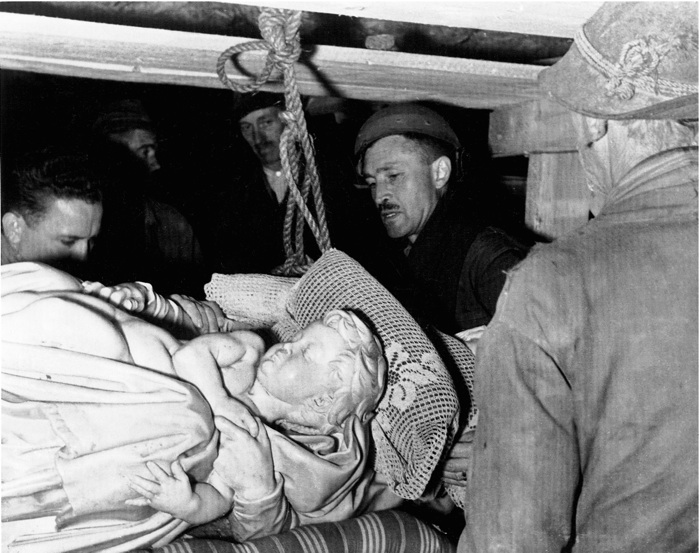George plays
the central character of George Stout (called Frank Stokes in the film) who
was a key player in the Monuments Men, or to give them their full title, the
Monuments, Fine Art and Archives (MFA&A) section. Set up by the
Allied Forces in World War II, they were entrusted with the mission of locating
and protecting works taken by the Nazi Regime. The film is based on the book of
the same name by Robert Edsel, and tells their remarkable story, based around a
simple job description: to save as much of the culture of Europe as they could
during combat.

Stout packing Michelangelo's Madonna of Bruges in the mines at Altaussee, Austria, July 1945
There are
many angles that could be followed off the back of the story, from Hitler’s
grand plans for the museum to outdo all other museums, the FuhrerMuseum in his
birthplace, Linz, Austria to the recent discovery of 1378 looted works of art
in the Munich home of Cornelius Gurlitt.
However,
warming to our theme, let us return to George Stout and the conservation
component of the Monuments Men story. Stout studied art history at
Harvard and was then drawn to the Fogg Museum (part of Harvard) for its unique
approach of applying science to the study and preservation of art, at a time
when art restoration was the preserve of art historian or artists.
In 1928, the Fogg director, Edward W. Forbes established the Fogg’s
Department for Technical Studies and named Stout as the museum’s first
conservator. In 1932 they launched 'Technical Studies in the Field of the Fine
Arts', the first journal dedicated to conservation related research. Partnering
with the chemist John Gettens, Stout then went on to produce 'Paintings Materials, A Short Encyclopaedia', which remains today a standard reference for
conservators.
As the attack
on Pearl Harbour in 1941 increased fears that the war would reach America,
Stout began work on a ‘cultural first aid’ manual for the armed forces
called 'Notes on Safeguarding and Conserving Cultural Material in the Field'. So
he was an obvious choice to be one of the first to join the Monuments Men when
it was formed in 1942. After the war he continued to have a distinguished
career, becoming
director of the Worcester Art Museum and the Isabella Stewart Gardener Museum
in Boston. More importantly, as a result of his Monuments Men experience
and his appreciation of how international conservation professionals can work
so well together, he was the driving force and one of the founding members of the International Institute for the Conservation of Historic and Artistic Works (IIC) of which I am privileged to
be currently Vice President.
Enjoy the
film, but do also read the book as it tells an astonishing story about some
truly passionate men who in the end saved some 2.5 million items including 468,000
works of art.



